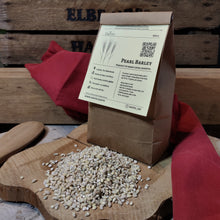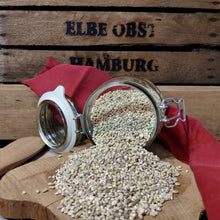Pearl barley can be used in many dishes. It is a great buffer to flavour-rich dishes. It can be used instead of risotto, rice or pasta. With its gentle nutty and creamy flavour it can adapt in any recipe, so do not be afraid to experiment! Find the nutritional value and how to cook pearl barley in the tabs below.
Most rice we eat, is grown in Asia. Whilst rice cannot grow in northern Europe, barley grows here easily! It is a quick switch to eating local!!
Arjen and Winny grew the barley by a so-called strip cropping method. Barley strips were separated by strips of linseed, onions, pumpkins, buckwheat and mixed flowers, to just name a few. This method truly enhances biodiversity!
Complete product details
Details
At a glance:
- Organic certified
- Rich in fibre
- Grown in The Netherlands
- Long shelf-life
- Alternative for rice or pasta
- Goes great with many dishes
Detailed information:
- Produced in: Lochem, The Netherlands
- Produced by: Arjen van Buuren and Winny van Buuren-Tessers
- Field objective: Strip agriculture
- Certificates: Organic certified
- Processed by: Meesters van de Halm
- Transport mode to warehouse: Transporter van
- Bulk storage: Multi-layered paper bags of 25 kg
- Packaging: unbleached kraft paper bag or swing-top jar
- How to recycle: Refill packaging with paper and carton
Cooking
For every 1 part of pearl barley add 4 parts of water. Depending on the dish, use 50 to 75 grams per person.
- Bring water to boil
- Add pearled barley
- Boil for 5 minutes then cover with a lid
- Let it stand for 1 hour.
- Serve and enjoy!
Nutrition
Pearl barley can replace rice or pasta in a wide variety of dishes. Pearl barley contains more protein, more fiber, but slightly more fat. When comparing pasta to pearl barley, the difference between wholemeal pasta and white pasta is, in contrary to rice, more noticeable. Pearl barley has more fiber than white pasta, but less fiber than wholemeal pasta. Pasta has on average 1 to 2.5 grams of protein more than barley. The percentage of fat is half of that in pasta.
Allergens: Gluten
| Nutritional value | Per 100 gram | Per portion (50 g) | RI* | ||
| Energy | 1467 kJ (346 kcal | 734 kJ (173 kcal) | |||
| Fat | 1.4 | g | 0.7 | g | |
| Of which saturated | 0.4 | g | 0.2 | g | |
| Carbohydrates | 70.1 | g | 35.1 | g | |
| Of which sugars | 2 | g | 1.0 | g | |
| Fiber | 4.6 | g | 2.3 | g | |
| Protein | 11 | g | 5.5 | g | |
| Salt | 0.01 | g | 0.0 | g | |
| Phosphorus | 221 | mg | 110.5 | mg | 32% |
| Magnesium | 79 | mg | 39.5 | mg | 21% |
| Iron | 2.5 | mg | 1.3 | mg | 18% |
| Copper | 0.4 | mg | 0.2 | mg | 40% |
| Manganese | 1.3 | mg | 0.7 | mg | 65% |
| Vitamin B3 | 4.6 | mg | 2.3 | mg | 29% |
| Thiamin/vitamin B1 | 0.2 | mg | 0.1 | mg | 18% |
*Reference intake of an average adult ( 8400 kJ/2000 kcal) per 100gr
Sustainability
As pearl barley is not a large commodity yet, there is also not so much information available on where conventional pearl barley comes from. And as other stores, both online and in the supermarket, do not share anything transparently, we do not have much to compare our Dutch grown barley with. But in case you are ordering from northwestern Europe, it is likely that our pearl barley is still one of the closest you will find. Though if you do find something closer to home, you know what to do! ;)
This barley was grown in a strip-cropping field as well as on small grain fields. By growing crops in strips we increase biodiversity, reduce pest and disease pressure and we ensure a better habitat for insects and wildlife.
As the Dutch landscape is mainly made up of grass and corn for animal feed, or intensive crops for export, such as potatoes, onions and flower bulbs. Grain, seed and pulse crops have almost completely disappeared from our fields.
Grain and seed crops are really good for the soil structure and it brings carbon into the soil. As it is almost impossible for the soil to only grow intensive crops, Dutch farmers sometimes grow a little bit grain. Though, farmers will not make a financial profit from grain cultivation, as the land prices are too high. Most of this grain goes to chicken and pig feed production, whilst grain for human consumption is still being imported.
Making grain attractive again for Dutch cultivation is a challenge, as prices in the supermarket would go up. But as agricultural soils are dangerously poor, grain crops would be very welcome. Ekoto takes on the challenge with farmers to grow grain locally again. By joining us, you have a vote in the Dutch landscape! Do we want monoculture, poor soils and artificial chemicals or do we want biodiverse fields, capturing carbon and all of that without artificial inputs?
Producer
In the east of the Netherlands, in the middle of a beautiful country estate named Velhorst, small diverse fields make up the landscape in which Arjen and Winny produce a wide variety of crops and manage a herd of different farm animals.
The barley was grown in a strip cropping field as well as on a variety of small-sized fields. Almost all fields at Velhorst are surrounded by 3 meter wild flower barriers and in the case of the strip cropping field, was the barley separated by a large variety of crops such as linseed, onions, buckwheat, pumpkins and lentils.




